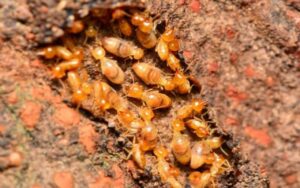Termites, woodworms, white ants, termight all are different Types of Termites Which destroy valuable furniture, antiques, sculptures, wooden decor, and any cellulose-based materials in general, We have previously discussed methods of dealing with pest control companies and how to avoid exploitation, One of the most important strategies is having some knowledge, even if just a little, about each pest commonly found in homes, residential complexes, industrial areas, and service sites like restaurants, hospitals, warehouses, and storage facilities.
Main Types of Termites
There are approximately 45 different species of termites in the United States and around 2,500 species worldwide, They are categorized into three main types:
Subterranean Termites
These termites live underground or inside wooden structures near the soil. They are the most common in the Arabian Gulf countries, especially Saudi Arabia, as they prefer warm, humid regions. Subterranean termites include:
- Eastern Subterranean Termite.
- Arid-Land Subterranean Termite.
- Western Subterranean Termite.
- Formosan Subterranean Termite.

Drywood Termites
This type poses a significant threat to homes as they can be found in every nook and cranny, with colonies inside walls, various household items, and even picture frames and wooden window frames.
Drywood termites can adapt to different environmental conditions and can hide in thin wooden structures no thicker than a pencil. However, dealing with this type is straightforward once the colony’s location is identified and eliminated.
Dampwood Termites
Dampwood termites are among the most well-known termite types and are commonly found near moist or decayed wooden debris. These termites are typically found in damp areas that contain wood debris.
Understanding the appearance, behavior, and damage signs of these three types of termites helps in early detection of infestations, saving on home repair costs.
Termite Control
Termites are among the most dangerous pests, causing losses amounting to billions of dollars annually worldwide. The key facts you should know about termites include their types, behaviors, and prevention methods.
Being well-versed in termite control strategies is crucial, whether you work in pest control or if your home or institution is at risk of infestation by these pests.
- Name in English: Termite.
- Scientific Name:Isoptera.
We have dedicated an article that explains in detail, with images, how to identify signs of termites in your home and how to track their swarms. It also features pictures of the most dangerous and widespread types in human environments.
Information About Termites
Although commonly referred to as ants, termites differ as their thorax and abdomen are directly connected without a waist.
- Termites are mysterious scavenger insects that are highly destructive.
- They build tunnels and entrances that are hard to access, and they destroy paper, books, wood in buildings and libraries, and sometimes even entire residences and furniture.
- They live in colonies whose approximate population can range from 30,000 to 2.5 million individuals.
- Termites feed on cellulose (paper, books, wood, clothing, furniture), or any material containing cellulose.

Termite colonies
Typically, termites live underground and form large colonies with various groups, each having different structures and roles.
Workers
These form the majority of the colony; they are usually blind and wingless and are responsible for damaging buildings in cooperation with newly born members.
Soldiers
They protect the colony from intruders like ants. In their final developmental stage, soldier termites have long, armored heads with strong jaws.
Queen
Each colony has one or more queens whose primary role is to lay eggs to develop the colony and support it with new members, When the primary queen dies, secondary queens are produced.
- New members are produced once a year, and a single colony can generate hundreds of them.
- When conditions are ideal, the new members leave the colony as a swarm to find mates and start new colonies. After a short flight, the swarm lands, breaks their wings, selects their partners, and begins looking for a small space under a stone or a piece of wood in contact with soil to establish their new colony.
Structure and Function of Each Individual in a Termite Colony
- Winged and Sexually Fertile Individuals
- They are active in the fall and spring, are dark-colored, have eyes for vision, and produce kings and queens to establish new colonies.
Queen
There is a single queen per colony who unites the colony members and lays eggs at a rate of six eggs per minute and lives with only one king in the colony.
Soldiers
Responsible for guarding and protecting the colony, they have strong mandibles and pointed heads. They are sterile, blind, and constitute 1-3% of the colony population.
Workers
The primary cause of damage because they feed the rest of the colony members. They are sterile and blind, making up 97% of the colony population.
Difference Between Termites and Regular Ants
Before delving into termite control methods, it’s important to differentiate between winged termites and regular ants; confusion often arises because mating in both species usually occurs at the same time of the year, and the winged members of both species are morphologically very similar.
- Winged Termites
Have straight antennae with a uniform waist and equal-sized wings, while regular ants have bent antennae, pinched waists, and forewings longer than their hind wings, Termites are attracted to light and are often seen around windows and doors.




